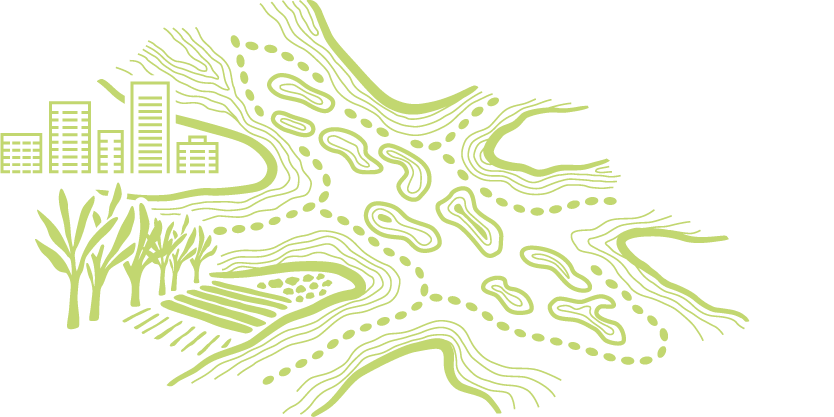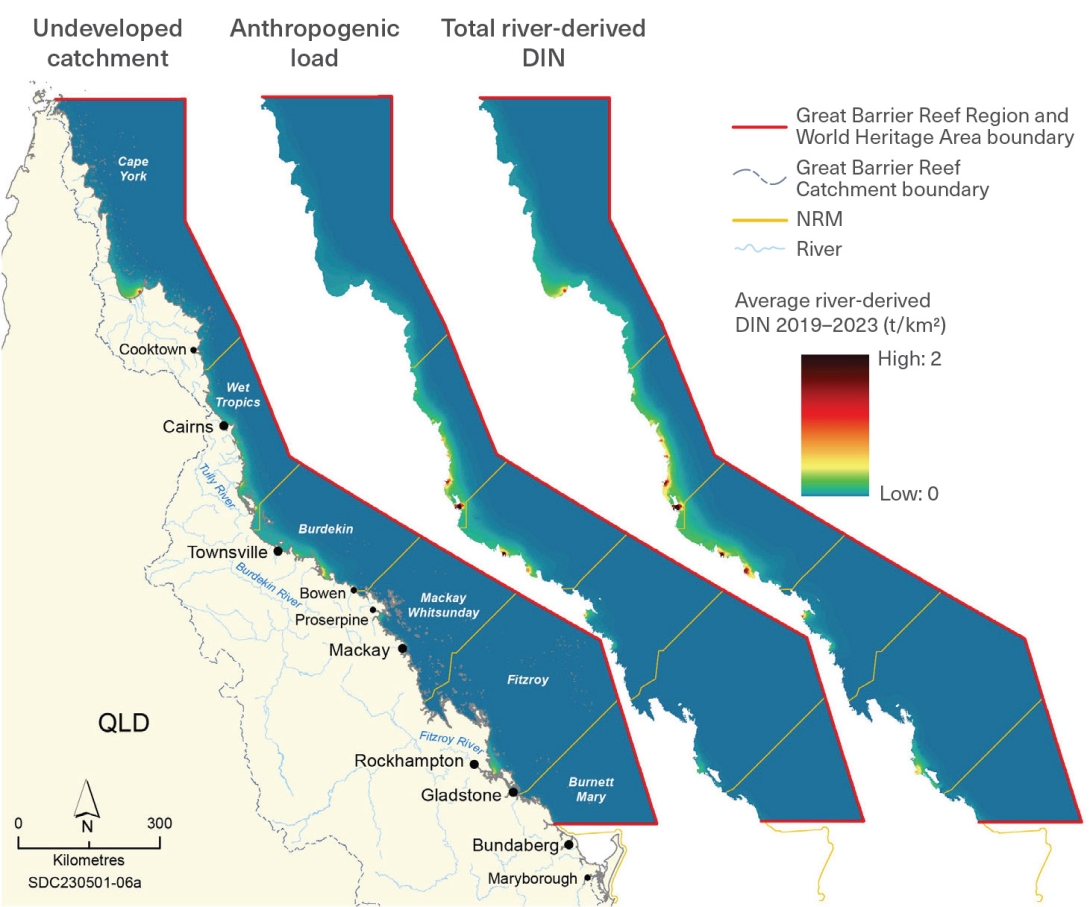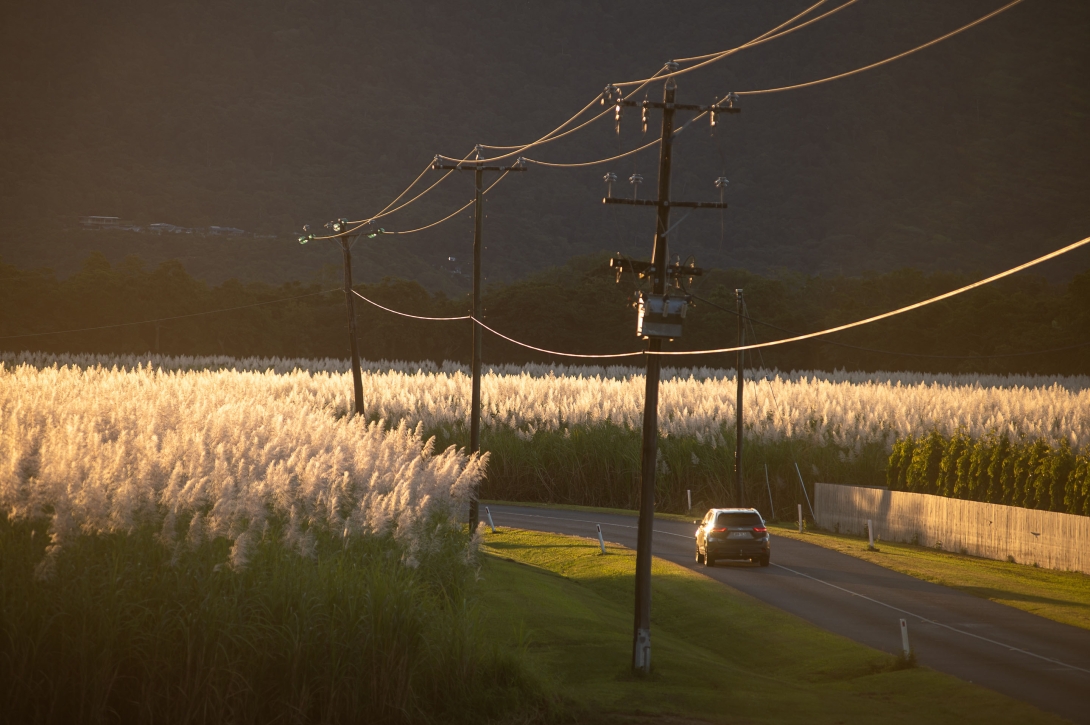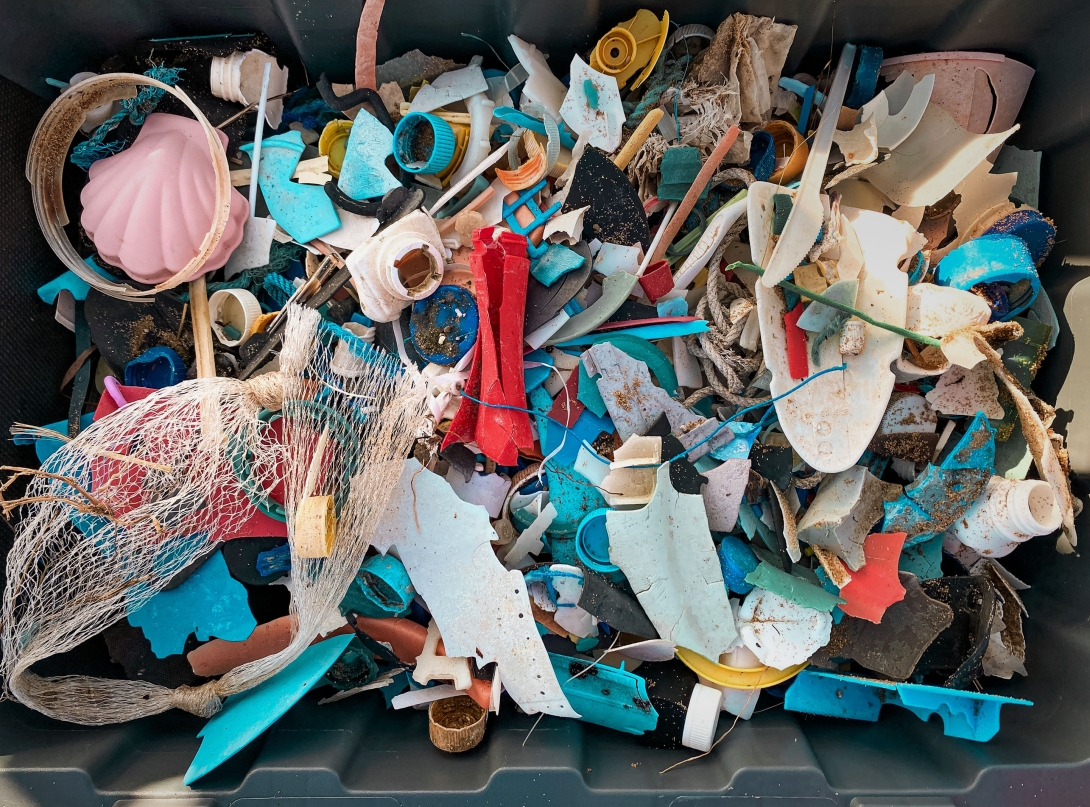39.
Collier, C., Brown, A., Fabricius, K., Lewis, S., Diaz-Pulido, G. et al. 2024, 2022 Scientific Consensus Statement: Summary | Evidence Statement for Question 3.2: What are the measured impacts of increased sediment and particulate nutrient loads on GBR ecosystems, what are the mechanism(s) for those impacts and where is there evidence of this occurring in the GBR? in 2022 Scientific Consensus Statement on land-based impacts on Great Barrier Reef water quality and ecosystem condition, eds J. Waterhouse, M. Pineda and K. Sambrook, Commonwealth of Australia and Queensland Government.
40.
McCloskey, G.L., Baheerathan, R., Dougall, C., Ellis, R., Bennett, F.R., et al. 2021, Modelled estimates of fine sediment and particulate nutrients delivered from the Great Barrier Reef catchments, Marine Pollution Bulletin 165: 112163.
145.
McKenzie, L.J., Collier, C.J., Langlois, L.A. and Yoshida, R.L. 2023, Marine Monitoring Program: annual report for inshore seagrass monitoring 2021–22. Report for the Great Barrier Reef Marine Park Authority, Great Barrier Reef Marine Park Authority, Townsville.
356.
Richardson, A., Eriksen, R., Moltmann, T., Hodgson-Johnston, I. and Wallis, J.R. 2020, State and Trends of Australia’s Ocean Report, Integrated Marine Observing System, Hobart.
363.
Moran, D., Robson, B., Gruber, R., Waterhouse, J., Logan, M., et al. 2023, Marine Monitoring Program Annual Report 2021-22 Water Quality, Great Barrier Reef Marine Park Authority, Townsville.
561.
Critchell, K., Grech, A., Schlaefer, J., Andutta, F.P., Lambrechts, J., et al. 2015, Modelling the fate of marine debris along a complex shoreline: Lessons from the Great Barrier Reef, Estuarine, Coastal and Shelf Science 167: 414-426.
574.
Lewis, S., Bainbridge, Z. and Smithers, S. 2024, 2022 Scientific Consensus Statement: Summary | Evidence Statement for Question 2.3: What evidence is there for changes in land-based runoff from pre-development estimates in the GBR? in 2022 Scientific Consensus Statement on land-based impacts on Great Barrier Reef water quality and ecosystem condition, eds J. Waterhouse, M. Pineda and K. Sambrook, Commonwealth of Australia and Queensland Government.
578.
Moran, D., Robson, B., Gruber, R., Waterhouse, J., Logan, M., et al. 2022, Marine Monitoring Program: Annual Report for Inshore Water Quality Monitoring 2020-21. Report for the Great Barrier Reef Marine Park Authority, Great Barrier Reef Marine Park Authority, Townsville.
579.
Gruber, R., Moran, D., Robson, B., Waterhouse, J., Logan, M., et al. 2024, Marine Monitoring Program: Annual report for inshore water quality monitoring 2022–23. Report for the Great Barrier Reef Marine Park Authority, Great Barrier Reef Marine Park Authority, Townsville.
586.
Lewis, S., Bainbridge, Z. and Smithers, S. 2024, 2022 Scientific Consensus Statement: Summary | Evidence Statement for Question 3.1: What are the spatial and temporal distributions of terrigenous sediments and associated indicators within the GBR? in 2022 Scientific Consensus Statement on land-based impacts on Great Barrier Reef water quality and ecosystem condition, eds J. Waterhouse, M. Pineda and K. Sambrook, Commonwealth of Australia and Queensland Government.
589.
Brodie, J.E., Lewis, S.E., Collier, C.J., Wooldridge, S., Bainbridge, Z.T., et al. 2017, Setting ecologically relevant targets for river pollutant loads to meet marine water quality requirements for the Great Barrier Reef, Australia: a preliminary methodology and analysis, Ocean &Coastal Management 143: 136-147.
595.
Garzon-Garcia, A., Burton, J.M., Lewis, S., Bainbridge, Z., De Hayr, R., et al. 2021, The bioavailability of nitrogen associated with sediment in riverine plumes of the Great Barrier Reef, Marine Pollution Bulletin 173: 112910.
693.
Waterhouse, J., Brodie, J., Tracey, D., Smith, R., Vandergragt, M., et al. 2017, Scientific Consensus Statement 2017: A synthesis of the science of land-based water quality impacts on the Great Barrier Reef, Chapter 3: The risk from anthropogenic pollutants to Great Barrier Reef coastal and marine ecosystems, State of Queensland, Brisbane.
705.
Strzelec, M., Proemse, B.C., Gault-Ringold, M., Boyd, P.W., Perron, M.M., et al. 2020, Atmospheric trace metal deposition near the Great Barrier Reef, Australia, Atmosphere 11(4): 390.
710.
Robson, B., Brown, A. and Uthicke, S. 2024, 2022 Scientific Consensus Statement: Summary | Evidence Statement for Question 4.1: What is the spatial and temporal distribution of nutrients and associated indicators within the GBR? in 2022 Scientific Consensus Statement on land-based impacts on Great Barrier Reef water quality and ecosystem condition, eds J. Waterhouse, M. Pineda and K. Sambrook, Commonwealth of Australia and Queensland Government.
951.
The State of Queensland (Department of Environment and Science) and Australian Government 2024, Reef Water Quality Report Card 2021- 2022, DES, Brisbane.
1734.
Lewis, S.E., Bartley, R., Wilkinson, S.N., Bainbridge, Z.T., Henderson, A.E., et al. 2021, Land use change in the river basins of the Great Barrier Reef, 1860 to 2019: A foundation for understanding environmental history across the catchment to reef continuum, Marine Pollution Bulletin 166: 112193.
-
1748.
McCloskey, G.L., Baheerathan, R., Dougall, C., Ellis, R., Bennett, F.R., et al. 2021, Modelled estimates of dissolved inorganic nitrogen exported to the Great Barrier Reef lagoon, Marine Pollution Bulletin 171: 112655.
1770.
Bartley, R., Waters, D., Turner, R., Kroon, F., Wilkinson, S., et al. 2017, Scientific Consensus Statement 2017: A Synthesis of the Science of Land-based Water Quality Impacts on the Great Barrier Reef, Chapter 2: Sources of sediment, nutrients, pesticides and other pollutants to the Great Barrier Reef, State of Queensland, Brisbane.
1816.
Furnas, M. 2003, Catchments and corals: Terrestrial runoff to the Great Barrier Reef, Australian Institute of Marine Science, Townsville.
1819.
Prosser, I.P. and Wilkinson, S.N. 2024, 2022 Scientific Consensus Statement: Summary | Evidence Statement for Question 3.3: How much anthropogenic sediment and particulate nutrients are exported from GBR catchments? in 2022 Scientific Consensus Statement on land-based impacts on Great Barrier Reef water quality and ecosystem condition, eds J. Waterhouse, M. Pineda and K. Sambrook, Commonwealth of Australia and Queensland Government.
1825.
Commonwealth of Australia and State of Queensland 2018, Reef 2050 Water Quality Improvement Plan 2017-2022, Reef Water Quality Protection Plan Secretariat, Brisbane.
-
1827.
State of Queensland 2022, Reef Water Quality Report Card 2020, Commonwealth Government and Queensland Government, Brisbane.
1828.
Warne, M., Neelamraju, C., Strauss, J., Smith, R.A., Turner, R.D.R., Mann, R.M. 2020, Development of a Pesticide Risk Baseline for the Reef 2050 Water Quality Improvement Plan, Department of Environment and Science, Brisbane.
1829.
Reinier, M., Turner, D.R., Neelamraju, C., Orr, D., Ferguson, B., et al. 2023, Great Barrier Reef Catchment Loads Monitoring Program: Loads and yields for sediment and nutrients, and Pesticide Risk Metric results (2020–2021) for rivers that discharge to the Great Barrier Reef, Department of Environment, Science and Innovation, Brisbane.
1830.
Kaserzon, S., Shiels, R., Elisei, G., Paxman, C., Li, Y., Carswell, C., Xia, S., Prasad, P., Gallen, M., Reeks, T., Thompson, K., Taucare, G., Marano, K., Gorji, S.G., Mueller, J. 2024, Marine Monitoring Program: annual report for inshore pesticide monitoring 2022–23. Report for the Great Barrier Reef Marine Park Authority, Great Barrier Reef Marine Park Authority, Townsville.
1831.
Prosser, I.P. and Wilkinson, S.N. 2024, 2022 Scientific Consensus Statement: Summary | Evidence Statement for Question 4.4: How much anthropogenic dissolved nutrient (nitrogen and phosphorus species) is exported from GBR catchments? in 2022 Scientific Consensus Statement on land-based impacts on Great Barrier Reef water quality and ecosystem condition, eds J. Waterhouse, M. Pineda and K. Sambrook, Commonwealth of Australia and Queensland Government.
1832.
Devlin, M., Schaffelke, B. 2009, Spatial extent of riverine flood plumes and exposure of marine ecosystems in the Tully coastal region, Great Barrier Reef, Marine and Freshwater Research 60(11): 1109-1122.
1833.
Furnas, M., Mitchell, A., Skuza, M. and Brodie, J. 2005, In the other 90%: phytoplankton responses to enhanced nutrient availability in the Great Barrier Reef Lagoon, Marine Pollution Bulletin 51(1-4): 253-265.
1834.
Bell, P.R.F. 2021, Analysis of satellite imagery using a simple algorithm supports evidence that Trichodesmium supplies a significant new nitrogen load to the GBR lagoon, Ambio 50(6): 1200-1210.
1835.
Sohm, J.A., Webb, E.A. and Capone, D.G. 2011, Emerging patterns of marine nitrogen fixation, Nature Reviews Microbiology 9(7): 499-508.
1836.
Waterhouse, J., Brodie, J., Lewis, S. and Mitchell, A. 2012, Quantifying the sources of pollutants in the Great Barrier Reef catchments and the relative risk to reef ecosystems, Marine Pollution Bulletin 65(4-9): 394-406.
1837.
Mitchell, A., Reghenzani, J., Faithful, J., Furnas, M., Brodie, J. 2009, Relationships between land use and nutrient concentrations in streams draining a ‘wet-tropics’ catchment in northern Australia, Marine and Freshwater Research 60(11): 1097-1108.
1838.
Stanley, J. and Reading, L. 2020, Nitrate dynamics in groundwater under sugarcane in a wet-tropics catchment, Heliyon 6(12): e05507.
1839.
Brodie, J., Lewis, S., Wooldridge, S., Bainbridge, Z., Waterhouse, J., Honchin, C. 2015, Ecologically relevant targets for pollutant discharge from the drainage basins of the Fitzroy Region, Great Barrier Reef, James Cook University, Townsville.
1840.
Devlin, M. and Brodie, J. 2023, Nutrients and Eutrophication, in Marine Pollution – Monitoring, management and mitigation, ed. A. Reichelt-Brushett, Springer, Cham, pp. 75-100.
1841.
Bainbridge, Z., Olley, J., Wilkinson, S., Bartley, R., Lewis, S., et al. 2023, Refining fine sediment source identification through integration of spatial modelling, concentration monitoring and source tracing: A case study in the Great Barrier Reef catchments, The Science of the Total Environment 892: 164731.
1842.
D'Olivo, J.P. and McCulloch, M. 2022, Impact of European settlement and land use changes on Great Barrier Reef river catchments reconstructed from long-term coral Ba/Ca records, The Science of the Total Environment 830: 154461.
1843.
Kroon, F.J., Kuhnert, P.M., Henderson, B.L., Wilkinson, S.N., Kinsey-Henderson, A., et al. 2012, River loads of suspended solids, nitrogen, phosphorus and herbicides delivered to the Great Barrier Reef lagoon, Marine Pollution Bulletin 65(4-9): 167-181.
1844.
Lewis, S., Packett, R., Dougall, C., Brodie, J., Bartley, R., et al. 2015, Fitzroy sediment story. A Report for the Fitzroy Basin Association. Report No. 15/74, TropWater (Centre for Tropical Water & Aquatic Ecosystem Research), James Cook University, Townsville.
1845.
Taucare, G., Bignert, A., Kaserzon, S., Thai, P., Mann, R.M., et al. 2022, Detecting long temporal trends of photosystem II herbicides (PSII) in the Great Barrier Reef lagoon, Marine Pollution Bulletin 177: 113490.
1846.
Skerratt, J., Baird, M.E., Mongin, M., Ellis, R., Smith, R.A., et al. 2023, Dispersal of the pesticide diuron in the Great Barrier Reef, The Science of the Total Environment 879: 163041.
1847.
Brodie, J. and Landos, M. 2019, Pesticides in Queensland and Great Barrier Reef waterways - potential impacts on aquatic ecosystems and the failure of national management, Estuarine, Coastal and Shelf Science 230: 106447.
1848.
Spilsbury, F.D., Warne, M.S.J. and Backhaus, T. 2020, Risk Assessment of Pesticide Mixtures in Australian Rivers Discharging to the Great Barrier Reef, Environmental Science & Technology 54(22): 14361-14371.
1849.
Negri, A.P., Taucare, G., Neale, P., Neelamraju, C., Kaminski, H., et al. 2024, 2022 Scientific Consensus Statement: Summary | Evidence Statement for Question 5.1: What is the spatial and temporal distribution of pesticides across GBR ecosystems? What are the (potential or observed) ecological impacts in these ecosystems? What evidence is there for pesticide risk? in 2022 Scientific Consensus Statement on land-based impacts on Great Barrier Reef water quality and ecosystem condition, eds J. Waterhouse, M. Pineda and K. Sambrook, Commonwealth of Australia and Queensland Government.
1850.
Warne, M.St.J., Neelamraju, C., Strauss, J., Smith R.A., Turner, R.D.R., Mann, R.M. 2020, Development of a method for estimating the toxicity of pesticide mixtures and a Pesticide Risk Baseline for the Reef 2050 Water Quality Improvement Plan, Queensland Government, Brisbane.
1851.
Prazeres, M., Gruber, R., Howley, C., Lewis, S., McKenzie, L., et al. 2024, Great Barrier Reef Marine Monitoring Program: Synthesis Report 2022–23, Great Barrier Reef Marine Park Authority, Townsville.
1852.
Warne, M.S.J., Neelamraju, C., Strauss, J., Turner, R.D.R., Smith, R.A., et al. 2023, Estimating the aquatic risk from exposure to up to twenty-two pesticide active ingredients in waterways discharging to the Great Barrier Reef, The Science of the Total Environment 892: 164632.
1853.
Water Quality & Investigations 2023,
Pesticide Risk Metric Dashboard, Department of Environment and Science, Queensland Government, Brisbane, <
https://prmdashboard.des.qld.gov.au/>.
1854.
King, O.C., Smith, R.A., Warne, M.S.J., van de Merwe, J.P., Connolly, R.M., et al. 2021, Combined impacts of photosystem II-inhibiting herbicides and light availability on seagrass and marine microalgae, Marine Ecology Progress Series 668: 215-230.
1855.
Thai, P., Paxman, C., Prasad, P., Elisei, G., Reeks, T., Eaglesham, G., Yeh, R., Tracey, D., Grant, S., Mueller, J. 2020, Marine Monitoring Program: Annual Report for inshore pesticide monitoring 2018-19. Report to the Great Barrier Reef Marine Park Authority, Great Barrier Reef Marine Park Authority, Townsville.
1856.
Gallen, C., Thai, P., Paxman, C., Prasad, P., Elisei, G., et al. 2019, Marine Monitoring Program: Annual Report for Inshore Pesticide Monitoring 2017-2018, Great Barrier Reef Marine Park Authority, Townsville.
1857.
Waterhouse, J., Gruber, R., Logan, M. Petus, C., Howley, C., et al. 2021, Marine Monitoring Program: Annual report for inshore water quality monitoring 2019-20, Great Barrier Reef Marine Park Authority, Townsville.
1858.
Beaumont, N.J., Aanesen, M., Austen, M.C., Börger, T., Clark, J.R., et al. 2019, Global ecological, social and economic impacts of marine plastic, Marine Pollution Bulletin 142: 189-195.
1859.
Rahman, M.N., Shozib, S.H., Akter, M.Y., Islam, A.R.M.T., Islam, M.S., et al. 2023, Microplastic as an invisible threat to the coral reefs: Sources, toxicity mechanisms, policy intervention, and the way forward, Journal of Hazardous Materials 454: 131522.
1860.
Gall, S.C. and Thompson, R.C. 2015, The impact of debris on marine life, Marine Pollution Bulletin 92(1-2): 170-179.
1861.
Critchell, K., Bauer-Civiello, A., Benham, C., Berry, K., Eagle, L., et al. 2019, Plastic pollution in the coastal environment: current challenges and future solutions, in Coasts and Estuaries, eds E. Wolanski, J.W. Day, M. Elliott and R. Ramachandran, Elsevier, pp. 595-609.
1862.
Rochman, C.M., Browne, M.A., Underwood, A.J., Van Franeker, J.A., Thompson, R.C., et al. 2016, The ecological impacts of marine debris: unraveling the demonstrated evidence from what is perceived, Ecology 97(2): 302-312.
1863.
Gacutan, J., Johnston, E.L., Tait, H., Smith, W. and Clark, G.F. 2022, Continental patterns in marine debris revealed by a decade of citizen science, The Science of the Total Environment 807(Pt 2): 150742.
1864.
Gacutan, J., Tait, H., Johnston, E.L. and Clark, G.F. 2023, Assessing human and physical drivers of macro-plastic debris spatially across Queensland, Australia, Environmental Pollution 330: 121731.
1865.
Smith, C.E., Gilby, B.L., van de Merwe, J., Jones, J., Tait, H., et al. 2024, Predictive modelling reveals Australian continental risk hotspots for marine debris interactions with key threatened species, Global Change Biology 30: e17313.
1866.
Australian Marine Debris Initiative and Tangaroa Blue Foundation. 2023, ReefClean 2022, tackling marine debris pollution on the Great Barrier Reef, Australian Marine Debris Initiative National – Tangaroa Blue, Australia.
1867.
Kroon, F.J., Berry, K.L.E., Brinkman, D.L., Kookana, R., Leusch, F.D.L., et al. 2020, Sources, presence and potential effects of contaminants of emerging concern in the marine environments of the Great Barrier Reef and Torres Strait, Australia, Science of the Total Environment 719: 135140.
1868.
Miller, M.E., Santana, M.F.M., Carsique, M., Motti, C.A., Hamann, M., et al. 2022, Temporal patterns of plastic contamination in surface waters at the SS Yongala shipwreck, Great Barrier Reef, Australia, Environmental Pollution 307: 119545.
1869.
Carbery, M., Herb, F., Reynes, J., Pham, C.K., Fong, W., et al. 2022, How small is the big problem? Small microplastics Marine Pollution Bulletin 184: 114179.
1870.
Hardesty, B.D., Wilcox, C., Lawson, T.J., Lansdell, M., van der Velde, T. 2014, Understanding the effects of marine debris on wildlife, Commonwealth Scientific and Industrial Research Organisation, Hobart.
1871.
Australian Microplastic Assessment Project 2023, Final overview of microplastics across GBR catchments: 2019-2023, Australian Microplastic Assessment Project (AUSMAP), Australia.
1872.
Roman, L., Warmbrunn, A., Lawson, T.J., Willis, K., Wilcox, C., et al. 2021, Comparing marine anthropogenic debris on inhabited mainland beaches, coastal islands, and uninhabited offshore islands: a case study from Queensland and the Coral Sea, Australia, Marine Pollution Bulletin 172: 112919.
1873.
Agamuthu, P., Mehran, S.B., Norkhairah, A. and Norkhairiyah, A. 2019, Marine debris: A review of impacts and global initiatives, Waste Management & Research 37(10): 987-1002.
-
1875.
Chariton, A. and Hejl, N. 2024, 2022 Scientific Consensus Statement: Summary | Evidence Statement for Question 6.1: What is the spatial and temporal distribution and risk of other pollutants in the GBR ecosystems, and what are the primary sources? in 2022 Scientific Consensus Statement on land-based impacts on Great Barrier Reef water quality and ecosystem condition, eds J. Waterhouse, M. Pineda and K. Sambrook, Commonwealth of Australia and Queensland Government.
1876.
Tebbett, S.B., Bellwood, D.R., Johnson, E.R. and Chase, T.J. 2022, Occurrence and accumulation of heavy metals in algal turf particulates and sediments on coral reefs, Marine Pollution Bulletin 184: 114113.
1877.
. Heffernan, A.L., del Mar Gómez-Ramos, M., Villa, C.A., Bell, I.P. and Gómez-Ramos, M.J. 2022, Untargeted screening of xenobiotics and metabolic profiles of green sea turtles on the Great Barrier Reef, in Applied Environmental Metabolomics, eds Beale, D. J., Hillyer, K. E., A.C. Warden and O.A.H. Jones, Academic Press, London, pp. 167-181.
1878.
Gallen, C., Heffernan, A.L., Kaserzon, S., Dogruer, G., Samanipour, S., et al. 2018, Integrated chemical exposure assessment of coastal green turtle foraging grounds on the Great Barrier Reef, Science of The Total Environment 657: 401-409.
1879.
van Dam, J.W., Negri, A. P., Uthicke, S., Mueller, J. F. 2011, Chemical pollution on coral reefs: exposure and ecological effects, in Ecological impacts of toxic chemicals, ed. Sánchez-Bayo, F., van den Brink, P. J., Mann, R. M., Bentham Science Publisher, United Arabic Emirates, pp. 187-211.







